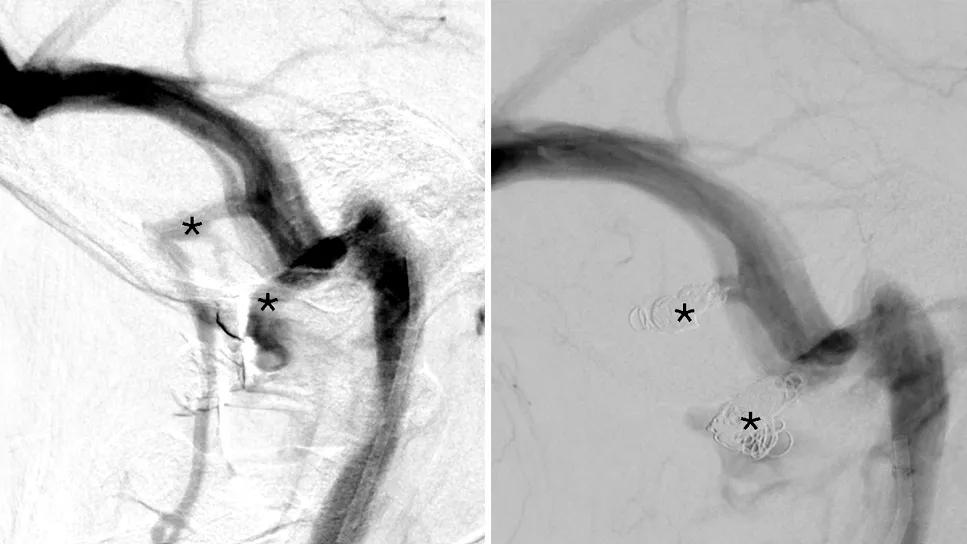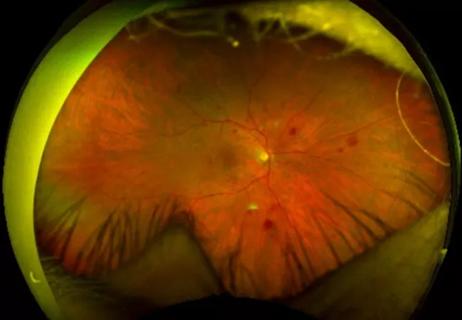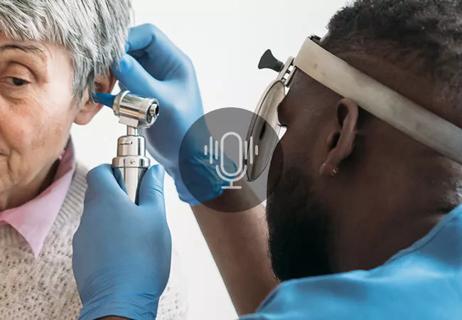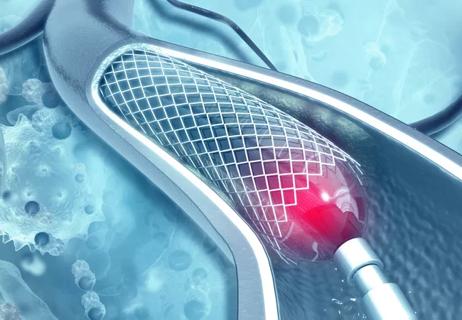Innovative approach to the procedure can yield significant relief in complex cases

A 58-year-old woman presented with symptoms she described as a loud “rumble” or “motor” sound on the right side of her head. She had previously been told by a community-based otolaryngologist that her problem was not treatable; however, she pursued a second opinion at Cleveland Clinic’s pulsatile tinnitus clinic.
Advertisement
Cleveland Clinic is a non-profit academic medical center. Advertising on our site helps support our mission. We do not endorse non-Cleveland Clinic products or services. Policy
The patient was initially seen by vascular neurologist Andrew Russman, DO, who referred her to otolaryngologist Edward Doyle, MD, and interventional neuroradiologist Scott Raymond, MD, PhD. Noninvasive imaging was ordered, including CT of the temporal bone, MRI of the head, MRA of the carotid artery and CT venography of the head. Scans ruled out nonvascular causes but identified large emissary veins as a possible factor.
During a physical exam, the woman reported that her pulsatile tinnitus decreased when she turned her head to the left. Compressing her right internal jugular vein caused her symptoms to worsen.
“That made me think, when we’re blocking the internal jugular, the blood flow has to go through these condylar emissary veins, so that may be what’s causing it,” Dr. Raymond explains.
Diagnostic cerebral angiography was performed with arterial and venous catheterization. The patient was awake during the procedure. Contrast injection via the right carotid artery delineated the arterial and venous phases. Having previously identified the emissary veins as a possible cause, Dr. Raymond temporarily blocked one of the veins by inflating a balloon catheter.
“It decreased her symptoms, but it didn’t completely eliminate them,” he says. “We couldn’t close off both veins at the same time, so I wasn’t sure if it was because the other vein was still open. At that point, I offered her embolization to see if we could reduce the symptoms.”
Although transvenous embolization is the only medical treatment for pulsatile tinnitus caused by emissary veins, Dr. Raymond rarely performs it.
Advertisement
“For the vast majority of patients I see, we don’t offer treatment when the cause is venous,” he notes.
Venous causes of pulsatile tinnitus are more common than arterial causes but are generally not dangerous on their own — unlike arterial causes, such as dural arteriovenous fistula, which can rupture.
In addition, the procedure itself is not risk free. Because this type of pulsatile tinnitus can sometimes resolve on its own, Dr. Raymond usually recommends monitoring and cognitive behavioral therapy, an evidence-based approach to improving quality of life.
In this case, however, it seemed likely that embolization would help, and the patient’s symptoms were so debilitating that he felt the procedure was warranted.
With the patient under general anesthesia, a microcatheter was placed in each emissary vein, which were then closed using intracranial coils. Dr. Raymond notes that he prefers these devices, which are typically used for cerebral aneurysms, over coils approved for vein embolization.
“These allow really precise placement and deployment,” he explains, “whereas coils used peripherally for veins often don’t allow the same degree of precision.”

Upon waking up, the patient initially reported that her symptoms were gone. Although mild symptoms did return over the next day, they were significantly improved. Ultimately, she said her symptoms were 85% to 90% resolved following the procedure.
Dr. Raymond was satisfied with this outcome, noting that the degree of improvement often depends on the underlying cause. While arterial causes can often be 100% resolved through treatment, “it’s challenging to get a complete cure if pulsatile tinnitus is from emissary veins,” he notes.
Advertisement
Dr. Raymond stresses that the top takeaway from this case is that pulsatile tinnitus may be treatable.
“By the time most of my patients get to me they say, ‘Oh, my physician said there’s nothing we can do. It’s not a dangerous problem; just ignore it,’” he says. “I don’t think that’s a very productive approach to the diagnosis.”
Physicians can rule out a dangerous cause with noninvasive imaging, but that shouldn’t be the end of the conversation. “Especially when symptoms are causing the patient distress,” Dr. Raymond concludes, “referral to a specialist can bring solutions and relief.”
Advertisement
Advertisement

A scannable recap of our latest data in these clinical areas

Site visits offer firsthand lessons in clinical and operational excellence in cardiovascular care

Effective screening, advanced treatments can help preserve quality of life

Auditory hallucinations lead to unusual diagnosis

Study identifies factors that may predict vision outcomes in diabetic macular edema

Hearing loss and its treatments are often misunderstood by both the public and healthcare professionals

When a patient failed to improve, the value of a comprehensive vestibular test was apparent

Benefits of new FDA safety determination go beyond expanding patients’ options